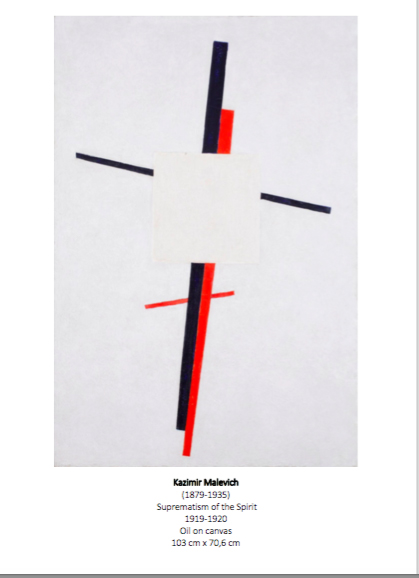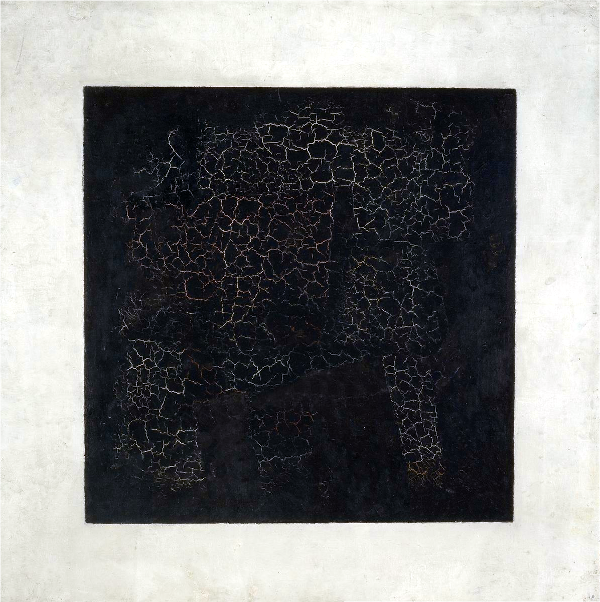Suprematist art, specially drawn in out-of-proportion size with the art concept, was a small standing mirror in which the materialistic men of a materialistic century could look at themselves…Suprematism presented to the Russian people the greatest aspects of non-objectivity in art and by so doing, open the way to a deeper understanding of art. Malevich was an intelligent in his stratagems for appealing to the plain sense of his utilitarian countrymen while not compromising his art doctrine.
Step by step throughout its development, he would present the squares and circles as inventions to aid the peasant in life and in the end, it would seem seekers for eternal life. It is most likely that in the first instances of the non-objective creations, Malevich was trying to slip something into the art of the Communist overseer…but when he always failed to gain the serious notice of the public servant, he finally revealed the real aim of his Being.
Through this struggle for acceptance of his art doctrine, Malevich showed a large amount of mordant wit in his politicking with the Communist art organizers. In this weak state of the intellectual elite in Russia, it proves the theory that the artist, no matter how true and dedicated he may be, is always a servant to the age in which he lives…but in Malevich’s example, he is also a leader of the future.
When a single individual comes to represent the symbol of an entire age, it is because he bears within himself the secrets and the future of that age. Malevich’s Suprematism is the most absolute development of modernist sensibility; and the servant of it. It is for this reason that Suprematism, from its beginning in 1913 to the late 1920s, was primarily a cultural force, at least in the mind of its originator.
As a result, in the tumult of early 20th-century Russia, Malevich emerged as a beacon of Suprematist art, challenging the conventions of representation with his fervent embrace of non-objectivity. His art doctrine, meticulously crafted, sought to liberate Russian art from the shackles of materialism, offering instead a portal to abstract realms. Malevich, a visionary of Russian art, navigated the turbulent waters of Modernism with unparalleled audacity, spearheading the avant-garde movement with his bold strokes and geometric forms.
As the cultural force of Suprematism swept through the intellectual elite, Malevich stood as its unwavering advocate, confronting the entrenched ideologies of his utilitarian countrymen. Through his artistic innovation, he transcended the confines of symbolism, weaving a tapestry of abstract expression that resonated with the future of art itself.
Malevich’s journey exemplifies the symbiotic relationship between artist and age, as he both mirrored the zeitgeist of his era and illuminated the path forward. His legacy, etched into the annals of Russian history, continues to inspire generations, reaffirming the enduring power of artistic vision in shaping the trajectory of civilization.

Of this, “Suprematism of the Spirit” is an iconic example. Matter of fact, “Suprematism of the Spirit” represents the culmination of Malevich’s artistic journey within the Suprematist movement, where he sought to push the boundaries of abstraction and express the ineffable through geometric forms and color.
In the years following the creation of his seminal work “Black Square” in 1915, Malevich continued to refine his ideas and experiment with geometric abstraction. His Suprematist compositions became more complex, incorporating a variety of shapes, lines, and colors arranged in dynamic compositions.
By the time he painted “Suprematism of the Spirit,” likely in 1919 or 1920, Malevich had fully embraced Suprematism as a means of expressing the spiritual essence of art. The title itself suggests a departure from the purely material or formal concerns of earlier Suprematist works towards a deeper exploration of metaphysical themes.
“Suprematism of the Spirit” may feature a composition dominated by geometric shapes and bold colors, typical of Malevich’s Suprematist style. However, it also likely conveys a sense of transcendence and inner harmony, reflecting Malevich’s belief in the ability of art to evoke spiritual truths beyond the material world.
As representatives of the owner, we are authorized to offer this exclusive work for sale.

